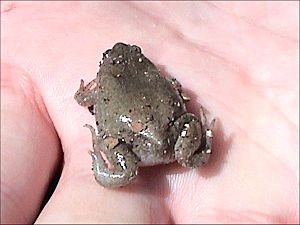Great Plains Narrowmouth Toad facts for kids
Quick facts for kids Great Plains Narrowmouth Toad |
|
|---|---|
 |
|
| Great Plains Narrowmouth Toad Gastrophryne olivacea |
|
| Conservation status | |
| Scientific classification | |
| Kingdom: | |
| Phylum: | |
| Class: | |
| Order: | |
| Suborder: | |
| Family: | |
| Subfamily: |
Microhylinae
|
| Genus: |
Gastrophryne
|
| Species: |
G. olivacea
|
| Binomial name | |
| Gastrophryne olivacea Hallowell, 1856
|
|
| Synonyms | |
|
Engystoma olivaceum |
|
The Great Plains Narrowmouth Toad (Gastrophryne olivacea) is a small, interesting species of toad. It's not a "true toad" like some others, but it's still part of the Microhylidae family. These toads are known for their unique narrow mouths.
They live in the south central United States and northern Mexico. You can find them in states like Nebraska and Texas. They are quite common and their numbers are stable. This means they are not currently in danger of disappearing.
Contents
About the Great Plains Narrowmouth Toad
The Great Plains Narrowmouth Toad is a small amphibian. It usually grows to be about 1 to 1.5 inches long. They have smooth skin, which is different from the bumpy skin of many other toads. Their color can vary a lot. They might be gray, olive green, or even reddish-brown. They often have darker spots or stripes on their backs.
One of their most noticeable features is their small, pointed head. This is where they get the "narrowmouth" part of their name. They also have a fold of skin behind their eyes. This fold helps to protect their eyes from dirt and dust.
Where They Live
These toads like to live in many different places. You can find them in prairies, grasslands, and even forests. They prefer areas with loose soil where they can easily burrow. They also like places near water, like ponds or temporary puddles.
They are often found hiding under rocks, logs, or leaf litter. They are mostly active at night, especially after it rains. During the day, they stay hidden to avoid the heat and predators.
What They Eat
The Great Plains Narrowmouth Toad has a special diet. Because of their narrow mouths, they mostly eat small insects. Their favorite foods are ants and termites. They use their sticky tongues to catch these tiny creatures.
They are important for controlling insect populations. This helps to keep the ecosystem healthy. They are very good at finding their food, even in the dark.
Life Cycle
The reproduction of the Great Plains Narrowmouth Toad usually happens after heavy rains. This is when temporary pools of water form. The male toads will gather around these pools and call out to attract females. Their call sounds like a high-pitched "waaaah."
The female lays her eggs in the water. The eggs are laid in a thin film on the surface. They hatch very quickly, sometimes in just a day or two. The tiny tadpoles then develop in the water. They feed on algae and other small bits of food.
The tadpoles grow quickly and change into small toadlets. This process is called metamorphosis. It can take a few weeks, depending on the temperature and food availability. Once they become toadlets, they leave the water and start their lives on land.
Behavior and Defense
These toads are mostly shy and secretive. When they feel threatened, they have a special defense. They can puff up their bodies to look bigger. They also release a bad-tasting substance from their skin. This makes them unappetizing to predators.
They are also very good at burrowing. They can quickly dig themselves into the soil. This helps them to escape from danger and to stay cool during hot weather. They are known to be territorial, meaning they will defend their living space from other toads.
Images for kids
See also
 In Spanish: Gastrophryne olivacea para niños
In Spanish: Gastrophryne olivacea para niños



